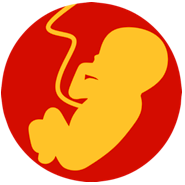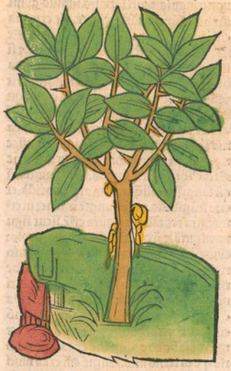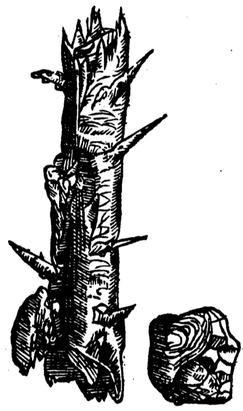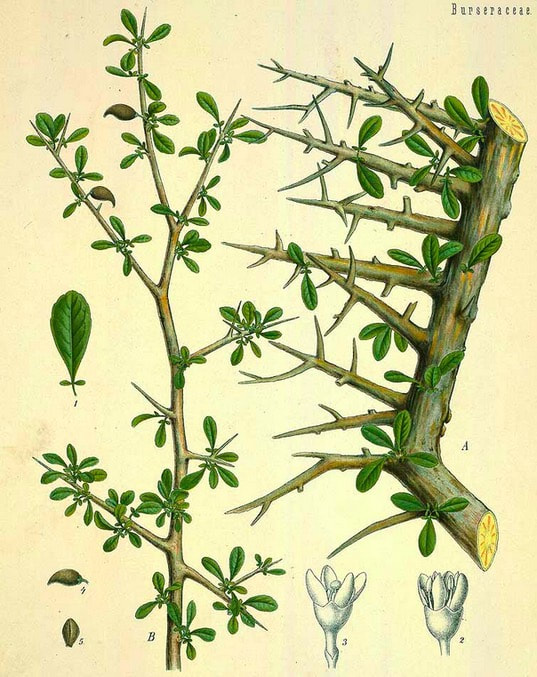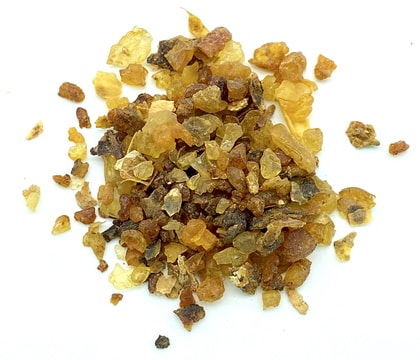Sentry Page Protection
Ortus Sanitatis, Meydenbach, 1491
Myrrh tree and gum
Parkinson, Theatrum Botanicum, 1640
Parkinson, Theatrum Botanicum, 1640
Koehler, Medizinal Pflanzen, 1890
Myrrh (Adam, 2022)
Botanical name:
Commiphora spp.
See also Stacte
Parts used:
Gum
The and was called Troglodytic (coming from Ethiopia).
The primary varieties were differentiated:
Temperature & Taste:
Warm, dry. Bitter, Pungent, Aromatic
"Hot and dry in the second degree" (Avicenna)
Classifications:
2A APERIENT MEDICINES. 2D ATTENUATERS OF CONGEALED BLOOD. 2F. PURIFYING. 2G. CLEANSING. 2K. RESOLVENT 2S. STRENGTHENING. 2T. GLUTINATE. 2W. SARCOTIC. 2X. INCARNATIVE
3A. SUDORIFICS & DIAPHORETICS. 3G. EMMENAGOGUE. 3K. EXPECTORANT. 3L. ANTI-TUSSIVE. 3M. ARTHRITICS. 3Q. ANTHELMINTIC
4d. PECTORAL. 4i. UTERINE. 4j. NERVINE. 4k. ARTHRITIC
Commiphora spp.
- C. myrrha (syn. C. molmol)–Ethiopian Myrrh, found in Somalia, Oman, Yemen, Eritrea, Ethiopia and Saudi Arabia
- C. abyssinica (syn. C. habessinica)–Arabian Myrrh or Abyssinian Myrrh
See also Stacte
Parts used:
Gum
The and was called Troglodytic (coming from Ethiopia).
The primary varieties were differentiated:
- Common Myrrh–Ethiopian or Arabian
- Bisabol Myrrh, Somali Myrrh, also called East Indian Myrrh; stronger and more pungent tasting
- Troglodytic Myrrh from Ethiopia; the best which is fat, reddish, clear, very bitter and light
- Arabian Myrrh
Temperature & Taste:
Warm, dry. Bitter, Pungent, Aromatic
"Hot and dry in the second degree" (Avicenna)
Classifications:
2A APERIENT MEDICINES. 2D ATTENUATERS OF CONGEALED BLOOD. 2F. PURIFYING. 2G. CLEANSING. 2K. RESOLVENT 2S. STRENGTHENING. 2T. GLUTINATE. 2W. SARCOTIC. 2X. INCARNATIVE
3A. SUDORIFICS & DIAPHORETICS. 3G. EMMENAGOGUE. 3K. EXPECTORANT. 3L. ANTI-TUSSIVE. 3M. ARTHRITICS. 3Q. ANTHELMINTIC
4d. PECTORAL. 4i. UTERINE. 4j. NERVINE. 4k. ARTHRITIC
Uses:
1. Moves the Blood, Clears Stasis, Eases Pain:
-pain from obstructed blood of the flesh, organs, muscles and joints
-Headache, Migraine, pain from Trauma; fixed, sharp, stabbing-type pain
-chronic Joint disease, Arthritis, Rheumatism
-used for Hard tumors associated with Blood stagnation
-"removes hard masses and blood stasis, and eliminates swelling and pain". (TCM: Da Ming)
-"injury with pain of the bone and tendon and blood stasis in the epigastrium and abdomen". (TCM: Zhen Quan)
2. Moves the Blood, Promotes Menstruation:
-obstructions of the Uterus; Amenorrhea, Dysmenorreha with clotting
-"Mollifies the hardness of the Matrix [Uterus]" (Pemell)
-promotes Conception by removing obstructions
-Promotes Labor: "Open and soften the Womb, provoke birth and afterbirth" (Culpeper)
-"promotes Abortion, and treats Puerperal Abdominal pain of woman" (TCM: Li Xun)
3. Clears Cold Phlegm, Stops Cough:
-Hoarseness, sore Throat, Tonsillitis, Bronchitis
-clears the Lungs, chronic Coughs, Pleurisy
-"good for chronic and moist cough associated with asthma, orthopnoea and chest pain" (Avicenna)
-"It clears the voice" (Avicenna)
4. Clears Cold Phlegm of the Stomach:
-clears Phlegm/Damp from the Stomach, Colic
-stops Fluxes (leakages including Diarrhea)
5. Resists Poison:
-prevents contagion during Epidemics; regularly used in Antidotes
-regarded as preventing Fever in Unani (ie. prevents Infection)
-Fevers, ‘especially Quartan cold Fits’; Matthiolus was cured of a Quartan Ague (Malarial Fever) by it.
-Venomous bites and Stings
-"used orally in cases of Scorpion bite" (Avicenna)
6. Kills Worms:
-Worms including Tapeworm
-recently found useful in treating Liver Fluke (Fascioliasis), Schistosomiasis
7. Externally:
-to soften Hardness, Lumps and Tumors,
-old Ulcers, green Wounds (especially of the Head)
-"heals the Ulcers and facilitates growth of flesh on Bones" (Avicenna)
-"treats various malignant sores, hemorrhoid and fistula" (TCM, Kai Bao Ben Cao)
-topically to Gangrene, St. Anthony’s Fire (Ergotism)
-applied to Ringworm
-held in the mouth for Hoarseness and dryness of the Throat
-mixed with milk and applied for purulent Opthalmia
-chewed and the juice swallowed for stinking Breath
-topically the strengthen the gums and prevents tooth decay (Avicenna)
-applied as a deodorant.
-when a little of the powder is used as a snuff "it cleanses the Brain" (Avicenna)
-"treats Nebula and Opacity in the eye with inflammation and pain". (TCM: Kai Bao Ben Cao)
-dissolves early stage Cataracts (Avicenna)
Dose:
1. Mostly used in Powders and Pills
2. Taken with wine, or made into a Tincture is strongest to move the Blood. Chinese sources recommended taking the powder (in formula) with hot wine.
Powder: 500mg–2 grams (half scruple–1 dram traditionally);
1200–1500mg per day for a week is used for Worms.
Decoction: 3–9 grams
Preparation:
1. Stir-Fried Myrrh:
It is stir-fried to enhance its ability to move blood, to make it easier to powder, and lessen its deleterious effects of the Stomach.
2. Vinegar-Fried Myrrh:
Preparing with Vinegar increases Blood moving and analgesic effects too.
Corrective:
Honey
Substitute:
1. Bdellium
2. Costus
3. Frankincense
Comment:
1. 'The difference between Bdellium and Myrrh: Bdellium in sight is somewhat like to Myrrh, but may be distinguished thus; Myrrh is extreme bitter, so is not Bdellium; again Myrrh is easier to be broken, and of a more quick sharp scent'. (Pemell)
2. Stacte is the name given to an oil expressed from a fresh type of Myrrh (according to Dioscorides). It is highly aromatic and was said to be very expensive.
1. Mostly used in Powders and Pills
2. Taken with wine, or made into a Tincture is strongest to move the Blood. Chinese sources recommended taking the powder (in formula) with hot wine.
Powder: 500mg–2 grams (half scruple–1 dram traditionally);
1200–1500mg per day for a week is used for Worms.
Decoction: 3–9 grams
Preparation:
1. Stir-Fried Myrrh:
It is stir-fried to enhance its ability to move blood, to make it easier to powder, and lessen its deleterious effects of the Stomach.
2. Vinegar-Fried Myrrh:
Preparing with Vinegar increases Blood moving and analgesic effects too.
Corrective:
Honey
Substitute:
1. Bdellium
2. Costus
3. Frankincense
Comment:
1. 'The difference between Bdellium and Myrrh: Bdellium in sight is somewhat like to Myrrh, but may be distinguished thus; Myrrh is extreme bitter, so is not Bdellium; again Myrrh is easier to be broken, and of a more quick sharp scent'. (Pemell)
2. Stacte is the name given to an oil expressed from a fresh type of Myrrh (according to Dioscorides). It is highly aromatic and was said to be very expensive.
Main Combinations:
Aloe & Myrrh
Myrrh & Frankincense
Saffron & Myrrh
Move the Blood:
1. Bruising, Blood stagnation:
i. Myrrh with Saffron
ii. Myrrh with Frankincense, Dragon's Blood, Rhubarb
iii. Myrrh with Lacca, Armenian Earth (as in Powder for Bruising Lesser)
iv. Myrrh with Amber, Madder, Comfrey, Frankincense (as in Powder for Bruises of Lemery)
v. Myrrh with Armenian Earth, Dragons Blood, Shilajit, Rhubarb, Madder, Clove, Amber (as in Tincture for Blood Stagnation)
Gynecology:
2. To promote Menstruation:
i. Myrrh with saffron
ii. Myrrh with Cinnamon, Savin, Celery seed, Indian Spikenard (as in Powder to Promote Menstruation)
iii. Myrrh with Opopanax, sagapen, Mint, Rue
iv. Myrrh with Savin, Rue, Castoreum
v. Myrrh with Olibanum, Mastic
vi. Madder, Juniper berry, Cinnamon, Myrrh (Wirtzung)
vii. and to promote Birth or expel a Dead Child, with Decoction of Lupins and Rue
viii. Myrrh with Saffron, Rose, Ammi, Aloeswood (as in Troches of Saffron of Nicholas)
ix. an enema of Myrrh and Rue promotes Menstruation (Avicenna)
3. To promote Labor:
i. Myrrh powder alone taken in doses of 2 scruples (2 ½ grams), or made into small honey pills
ii. Myrrh with Cinnamon, Saffron, Amber (as in Birth Powder)
iii. Myrrh with Savin, Pennyroyal, Mugwort, Cassia Fistula, Saffron, Cinnamon (as in Powder to Facilitate Birth of Renodeus)
4. Postpartum Abdominal pain and spotting from Blood Stagnation:
i. Myrrh, Comfrey, Peach kernel, Saffron
ii. Myrrh, Dang Gui, Ligusticum Chuan Xiong, Corydalis Yan Hu Suo, Safflower (Hong Hua), Motherwort (Yi Mu Cao) (TCM)
Lungs:
5. Cold and dry Cough, Myrrh with Saffron, Pine nut, Quince seed, Aniseed, Sweet Almond, White Poppy seed, Licorice juice
6. Bronchitis, Myrrh with Elecampane, Mullein, Cinnamon
7. Asthma, and to promote Menstruation, Myrrh with Saffron, Hyssop, Coltsfoot, Maidenhair, Raisins (as in Syrup of Myrrh)
8. Chest obstruction (Heart and Lung) Myrrh with Frankincense, Licorice, Saffron, Cassia Wood
9. Phthisis:
i. pituitous, Myrrh, with Asafetida, Bittersweet, Licorice
ii. Myrrh with Venetian Turpentine, Frankincense, Orris (Boerhaave)
Infection:
10. To prevent infection during Epidemics, Myrrh with Aloe and Saffron (as in Pills of Ruffus [Common Pills])
11. Head Cold, Myrrh with White Pepper, Orris, Dill, in Wine (Dioscorides)
12. Quartan Agues, Intermittent Fever (Malarial Fever):
i. Myrrh and Black Pepper prevents Intermittent Fever in its early stage (Avicenna)
ii. pills made with Myrrh, Theriac and Birthwort (taken an hour before the fit for many days) (Pemell)
Other:
13. Arthritis and Joint diseases:
i. Myrrh with Aloe, Rhubarb, Agaric (as in Pills for Joint Disease)
ii. Myrrh, Angelica pubescens Du Huo, Saposhnikovia Fang Feng, Mistletoe (Sang Ji Sheng), Clematis Wei Ling Xian (TCM)
iii. Rhubarb, Myrrh, Aloe, Cinnamon, Mastic, Aloeswood (2 scruples each), Musk (1 grain), Oxymel enough to form pills. Dose: 1 scruple. (The Secrets of Alexis, 1615)
iv. Myrrh with prepared Nux Vomica (Ma Qian Zi), Frankincense (Ru Xiang), Scorpion (Quan Xie), Ephedra Ma Huang, Achyranthes Niu Xi (as in Feng Shi Ma Qian Pian)
14. Liver Heat and obstruction, Myrrh with Costus, Saffron, Aloe, Storax, Bitter Almond, Gentian, Wormwood (as in Antidote for the Liver and Chronic Cough)
15. Liver hardness, Fibroid Tumors, Myrrh with Lacca, Saffron, Costus, Madder, Licorice, Black Pepper, Rhubarb (as in Powder of Gum Lacca Lesser (Dialacca Minor) of Mesue)
16. Diabetes, Myrrh, Chebulic Myrobalan
17. Poor memory:
i. Myrrh with Frankincense and Cyperus rotundus (as in Electuary of Frankincense of Wirtzung)
ii. Myrrh with Calamus, Nutmeg, Clove, Frankincense (as in Pills to Increase Memory)
18. Worms:
i. Myrrh with Gentian and Wormseed (Wirtzung)
ii. Myrrh with Fern, Embelia ribes, Turpeth, Lupin, Myrrh, Mallotus philippinensis (equal parts) (Dispensatory of Ibn at Timid)
iii. enemas of decoction of Myrrh and Wormwood or Rue (Avicenna)
Externally:
19. Head wounds; wash the wounds and apply powder of equal parts of Frankincense, Myrrh and Aloes
20. Mouth Ulcers or Gums Boils:
i. apply powder of Myrrh, Gall and Frankincense bark (or Gum) mixed with Honey (Avicenna)
ii. Myrrh with Golden Seal or Rhubarb or Coptis, equal parts; apply topically
21. Douche for Ulcerated Uterus, Leek, Elder berry, Hartwort, Aniseed, Frankincense and Myrrh, decocted in wine. (Hippocrates)
22. To promote thick hair growth, Myrrh is mixed with Myrtle oil and Ladanum oil (Avicenna)
23. Scars:
i. Myrrh, Saffron, Calf (or other) Fat, Olive oil, form an ointment and apply warm (The Secrets of Alexis, 1615)
ii. Myrrh, Aloe, Rhubarb, Saffron, Zedoary, Gentian as a tincture topically. (as in Swedish Bitters)
iii. Myrrh is mixed with Myrtle oil and Ladanum oil (Avicenna)
24. Warts, decoct Myrrh with Honey and Cassia bark and apply. (Avicenna)
25. Applied topically to the armpits with Alum and Wine as an deodorant. (Avicenna)
26. Applied with vinegar cures Ringworm (Avicenna)
27. "When used as a mouth wash with wine and olive oil, it strengthens the teeth, facilitates their tight fixation, prevents tooth decay". (Avicenna)
Major Formulas
Tincture of Myrrh and Aloes
Troches of Myrrh (Rhasis)
Theriac of Four Ingredients (Diatessaron)
Pills Against Pestilence Magistrale
Pestilential Pills of Basil
Pills for Catarrh
Pills for Joint Disease
Pills for many Diseases of the Body
Pills to Increase Memory
Powder for Severe Sore Throat
Powder of Gum Lacca Lesser (Dialacca Minor) (Mesue)
Powder to Promote Menstruation (Rondeletius)
Powder to Move Blood (Wirtzung)
Powder for Bruising LesserTrauma PowderTroches of Gums
Powder for Wounds
Confection for all Diseases of the Eyes
Electuary of Saffron Lesser (Diacrocon Minus) (Mesue)
Antidotus Acharistos Altera
Birth Powder
Boladi Vati (Ayurveda)
Shen Tong Zhu Yu Tang
Xi Huang Wan
Feng Shi Ma Qian Pian
1. Good Samaritan Liniment:
i. Tincture of Myrrh, Oil of Wintergreen (4 fl. oz. each), Oregano oil (2 fl. oz.), Oil of Sassafras, Oil of Hemlock, Spirit of Turpentine, Tincture of Capsicum, Tincture of Opium (1 fl. oz. each), Camphor (2 oz.), Chloroform (1 ½ fl. oz.), Alcohol (4 pints).
Cautions:
1. Not used during pregnancy
2. Heavy and hard of digestion
3. Not used for pain associated with Blood deficiency
4. Overuse dries the Yin and lessens Seed
Toxicity
–Toxicity studies in mice of Commiphora molmol oleo-gum-resin.
Drug Interaction
May interfere with anticogaulant therapy.
–Antagonism of the anticoagulant effect of warfarin caused by the use of Commiphora molmol as a herbal medication: a case report.
Main Preparations used:
Prepared Myrrh (washed with a juice, infusion, decoction or Wine, then dry gently), Extract, Oil, Liquor, Tincture of Myrrh
1. Water Extract of Myrrh:
i. Myrrh (1 part), Water (4 parts). Digest in a covered vessel in a warm place, then set aside to cool and leave for 24 hours; decant, strain and evaporate over a slow fire. (Pharmacopoeia Oldenburgica, 1801)
2. Tincture of Myrrh:
i. Myrrh bruised (4 oz.), Rectified Spirit (3 pints). Macerate 14 days, filter. (London)
1. Not used during pregnancy
2. Heavy and hard of digestion
3. Not used for pain associated with Blood deficiency
4. Overuse dries the Yin and lessens Seed
Toxicity
–Toxicity studies in mice of Commiphora molmol oleo-gum-resin.
Drug Interaction
May interfere with anticogaulant therapy.
–Antagonism of the anticoagulant effect of warfarin caused by the use of Commiphora molmol as a herbal medication: a case report.
Main Preparations used:
Prepared Myrrh (washed with a juice, infusion, decoction or Wine, then dry gently), Extract, Oil, Liquor, Tincture of Myrrh
1. Water Extract of Myrrh:
i. Myrrh (1 part), Water (4 parts). Digest in a covered vessel in a warm place, then set aside to cool and leave for 24 hours; decant, strain and evaporate over a slow fire. (Pharmacopoeia Oldenburgica, 1801)
2. Tincture of Myrrh:
i. Myrrh bruised (4 oz.), Rectified Spirit (3 pints). Macerate 14 days, filter. (London)
Click the Tabs above for more information on this Medicine
|
Myrrh has been used from the earliest times together with olibanum as a constituent of incense, perfumes, and unguents. It was an ingredient of the holy oil used in the Jewish ceremonial as laid down by Moses: and it was also one of the numerous components of the celebrated Kyphi of the Egyptians, a preparation used in fumigations, medicine, and the process of embalming, and of which there were several varieties.
In the previous article we have pointed out several early references to myrrh in connection with olibanum, in which it is observable that the myrrh (when weights are mentioned) is always in the smaller quantity. Of the use of the drug in medieval Europe there are few notices, but they tend to show that the commodity was rare and precious. This myrrh is recommended in the Anglo-Saxon Leech- books to be used with frankincense in the superstitious medical practice of the 11th century. In a manuscript of the Monastery of Rheinau, near Schaffhausen, Switzerland, we also find that, apparently in the 11th century, myrrh as well as olibanum were used in ordeals in the "judicium aquae bullientis." The drug was also used by the Welsh "Physicians of Myddfai" in the 13th century. In the Wardrobe accounts of Edward I. there is an entry under date 6th January, 1299, for gold, frankincense, and myrrh, offered by the king in his chapel on that day, it being the Feast of Epiphany. Myrrh again figures in the accounts of Geoffroi de Fleuri, master of the wardrobe (argentier) to Philippe le Long, king of France, where record is made of the purchase of— "4 ounces d'estorat calmite" (Styrax) et mierre (myrrh) .... encenz et laudanon," (Ladanum, the resin of Cistus creticus L.)— for the funeral of John, posthumous son of Louis X., A.D. 1316. |
Gold, silver, silk, precious stones, pearls, camphor, musk, myrrh, and spices are enumerated as the presents which the Khan of Cathay sent to Pope Benedict XII. at Avignon about the year 1342. The myrrh destined for this circuitous route to Europe was doubtless that of the Arabian traders, with whom the Chinese had constant intercourse during the middle ages. Myrrh in fact is still somewhat largely consumed in China.
The name Myrrh is from the Hebrew and Arabic Mur, meaning, bitter, whence also the Greek {?}. The ancient Egyptian Bola or Bal, and the Sanskrit Vola are preserved in the Persian and Indian words Bol, Bola, and Heera-bol, well-known names for myrrh. Stacte, a substance often mentioned by the ancients, is said by Pliny to be a spontaneous liquid exudation of the myrrh tree, more valuable than myrrh itself. The author of the Periplus of the Erythrean Sea represents it as exported from Muzain Arabia together with myrrh. Theophrastus speaks of myrrh as of two kinds, solid and liquid. No drug of modern times has been identified with the stacte or liquid myrrh of the ancients: that it was a substance obtainable in quantity seems evident from the fact that 150 pounds of it, said to be the offering of an Egyptian city, were presented to St. Silvester at Rome, A.D. 314-335. The myrrh of the ancients was not always obtained from Arabia. The author of the Periplus, who wrote about A.D. 64, records it to have been an export of Abalites, Malao, and Mosyllon (the last-named the modern Berbera), ancient ports of the African coast outside the straits of Bab-el-Mandeb; and he even mentions that it is conveyed by small vessels to the opposite shores of Arabia. (Pharmacographia, Fluckiger & Hanbury, 1879) |

